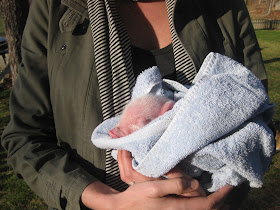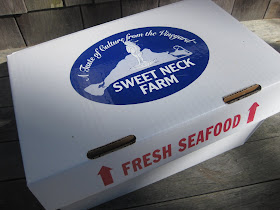This year I spent Easter with friends on Martha’s Vineyard. Many people think of the Vineyard as only a summer destination and while it is glorious at that time of year, fall, winter, and spring are quite spectacular, too. We couldn’t have asked for better weather for our spring weekend and spent most of the time going on walks and driving around the island, enjoying the fact there were no crowds or traffic.
Oh, yeah...and there was a bit of eating going on, too. Given that everyone in the house was a foodie (including two incredibly talented Boston chefs, Barbara and Kevin), we happily spent the days leading up to Easter Sunday gathering a feast of local foods – eggs and pork sausage from Packer Farm (where we also saw piglets that had been born less than 24 hours before),

and racks of lamb from Allen Farm in Chilmark.
But the surprise hit of the weekend were Sweet Neck Farm oysters, raised in the waters off Edgartown.
I say surprise hit because we hadn’t planned on serving oysters and only a fortuitous dinner at a favorite Oak Bluffs restaurant sealed our fate. I got to the island a day before everyone else with Curt, my friend since high school. His family has had a house on MVI since the 1950’s and he has been generously inviting me to visit for years. We decided to go to Offshore Ale for dinner on Friday night and while having burgers and a couple of their home brewed beers, I noticed a sign saying they were serving Martha’s Vineyard Sweet Neck oysters. Neither of us had had them before so we decided to order a few. We managed to get the last oysters of the night and were blown away by their sweet, clean flavor.
The next day on a whim I called Sweet Neck Farm to see if we could buy two dozen for Easter dinner. I spoke to the owner, Jack Blake, and as luck would have it, he was in the middle of boxing oysters for shipping and told us we were welcome to stop by and pick some up. Curt and I hopped in the car, drove to Edgartown, made a left at the jail (the prettiest jail you've ever seen), and found the land-based portion of their business on Norton Orchard Road. Jack and his wife, Sue, work in a little white shed off the side of their house, preparing their oysters to be shipped to restaurants and wholesalers across the country.
Jack told us he was a scallop fisherman for years until there were no more scallops left to harvest. He realized his future depended on sustainable harvests and switched to farming oysters.
The water-based portion of their operation is a one-acre site in Katama Bay. Jack is as much inventor as fisherman and has designed an upweller raft that constantly moves the plankton-rich water through the oyster seed he purchases from a certified hatchery. This continuous feeding of nutrients is what causes the oysters to grow and double in size weekly. After ten weeks the oyster cage is hoisted out of the water onto the raft where they are placed in a Jack-designed tumbler.
The tumbler is a feature that helps set Sweet Necks apart from other oysters. It is a cylindrical cage that spins partially in the water, tumbling the oysters against each other. This action cleans them of fouling and removes the sharp edges of the shells. Not only does this produce beautiful shells that are easier to handle while shucking, the chipping off of new shell growth produces a deeper cupped, stronger shell.
Finally, the tumbling shells are sprayed with pressurized water to remove silt from the crevices. The end result is a pristine oyster. Sweet Necks come in two sizes - cocktail and large - and are packed in boxes flat side up. As Curt and I learned, if you keep oysters in this position in the refrigerator you can store them for at least a month. That was a revelation to us; our trip to Edgartown for 24 oysters turned into a box of 100!
Just as important to me as how delicious and gorgeous Sweet Neck Farm oysters are is that they grow them in a way that is light on the environment; their upweller is tidal powered and all the machinery, including the tumbler, are powered by a wind turbine. Sustainable farms tends to be the norm on the Vineyard and Jack and Sue's rank right up there with the best of them.
To be honest, we were so excited with our little surprise we didn’t give much thought to how we were going to serve the oysters beyond raw with a squeeze of lemon and maybe a dash of Tabasco. And given how fresh and sweet they were I’m pretty sure everyone would have been perfectly happy to eat them just like that.
This was a moment when having a chef like Barbara in the house made a big, tasty difference. She heard we had oysters, immediately got on the phone to Kevin who was out and about in the car, and asked him to pick up Prosecco and white wine vinegar so she could make her mignonette sauce. He somehow managed to find stores open on Easter Sunday with those ingredients and brought them home. Mignonette is simple to prepare and gives you the tang and heat of lemon and Tabasco but is much more sophisticated – a lovely accompaniment to a special oyster.
Oysters on the Half Shell with Sparkling Mignonette
From Stir by Barbara Lynch
Lucky To Have A Chef In The House Moment #2 - Kevin later took the asparagus we were roasting for dinner and tossed them with the leftover mignonette, adding wonderful flavor while wasting nothing (a sure sign of a successful chef and restaurant owner). Perfection. Did I pick the right friends to spend Easter with or what??
2 tablespoons freshly ground black pepper
2 shallots, very finely chopped (about ½ cup)
½ cup Prosecco or other dry sparkling wine
½ cup white wine vinegar, preferably Chardonnay
1 teaspoon kosher salt
As many of your favorite oysters as you and your friends want to eat, rinsed and shucked
Using a fine-mesh strainer, sift the ground pepper and reserve only the coarsely ground pepper left behind in the strainer (If you include the finely ground pepper, the mignonette sauce will be too hot.)
In a medium bowl, combine all the ingredients except the oysters. Taste and correct the seasoning if necessary and keep chilled. Put just a few drops of the mignonette on each oyster before serving.
* The mignonette lasts for two days, covered and refrigerated, but the bubbles from the Prosecco will dissipate.










No comments:
Post a Comment
Note: Only a member of this blog may post a comment.